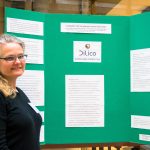Interactive Research Showcase
At Sheridan’s recent Interactive Research Showcase, Kirsten Madsen was honored for her contributions as the Chair of the
Research Ethics Board and her research with girls at risk. Dr. Madsen developed Sheridan’s Research Ethics Board as well as the board’s policies and procedures.
Her own ongoing research is in response to the concerns raised by community members and staff from Dilico Anishinabek family care about the growing number of girls being referred to their services. As such, the Talking Back research project began. The Talking Back project is a qualitative study which involves researchers, clinicians, and the girls working collaboratively to advance our knowledge of the development of First Nations girls.
Our department was also represented by Jessica Pulis, and Jamie Gitner.
Jessica’s project, entitled “Built in Biases: The Use of Probation with Girls and Aboriginal Youth in Ontario”, was a presentation of findings from a section of Jessica’s dissertation. The research explores the use of judicial sanctions, in particular probation, with girls and Aboriginal youth. The research findings suggest the increased use of probation with girls and Aboriginal youth is problematic because they may have difficulty meeting probation conditions and their probation failures are becoming a significant pathway into detention and incarceration.
Jamie’s project, presented the findings of a collaborative research project entitled “Vitamin D Status of Older Adults of Diverse Ancestry Living in the Greater Toronto Area”. This study explored the vitamin D status in a sample of community dwelling, active older adults (age > 60 years) of diverse ancestry living in the Greater Toronto Area. Vitamin D status was assessed from serum 25-hydroxyvitamin D (25(OH)D) concentrations, and daily intakes of vitamin D from diet and supplements. Physiological and lifestyle factors put older adults at an increased risk of vitamin D insufficiency and resulting negative health outcomes, yet only a small number (12.1%) of the participants in this study would be considered to have insufficient vitamin D levels. There were no significant differences in vitamin D status between the different ancestral groups, but females had significantly higher serum 25(OH)D concentrations than males. High daily intakes of vitamin D supplements likely account for the small proportion of participants with vitamin D insufficiency. Jamie’s study is being published in the journal BMC Geriatrics.
- Jamie Gitner, Kirsten Madsen, Jessica Pulis
- Kirsten Madsen
- Jessica Pulis
- Jamie Gitner
Many thanks to Haltech who took these wonderful photos!






